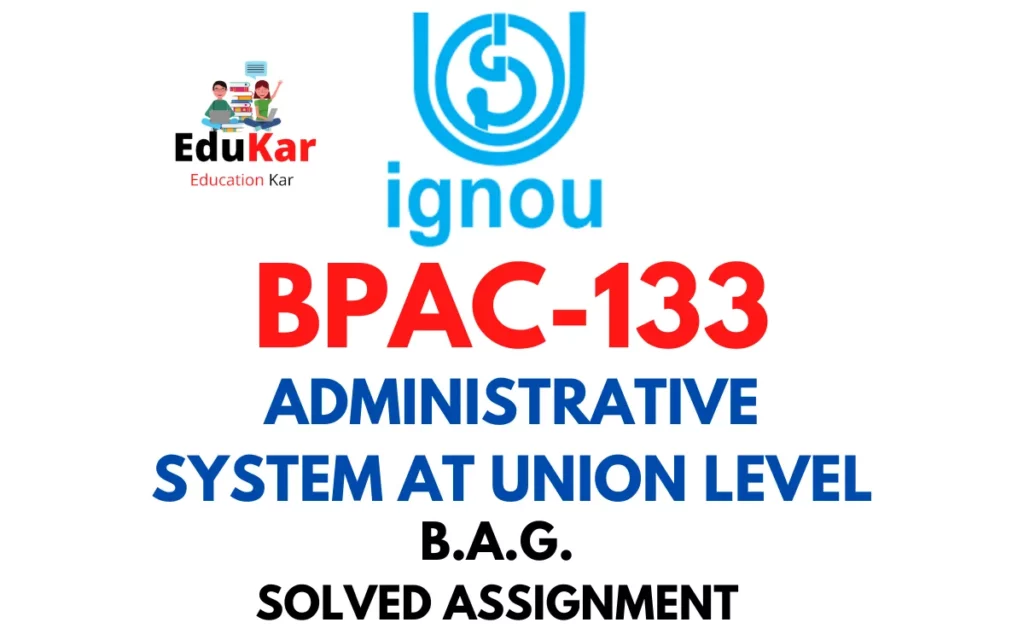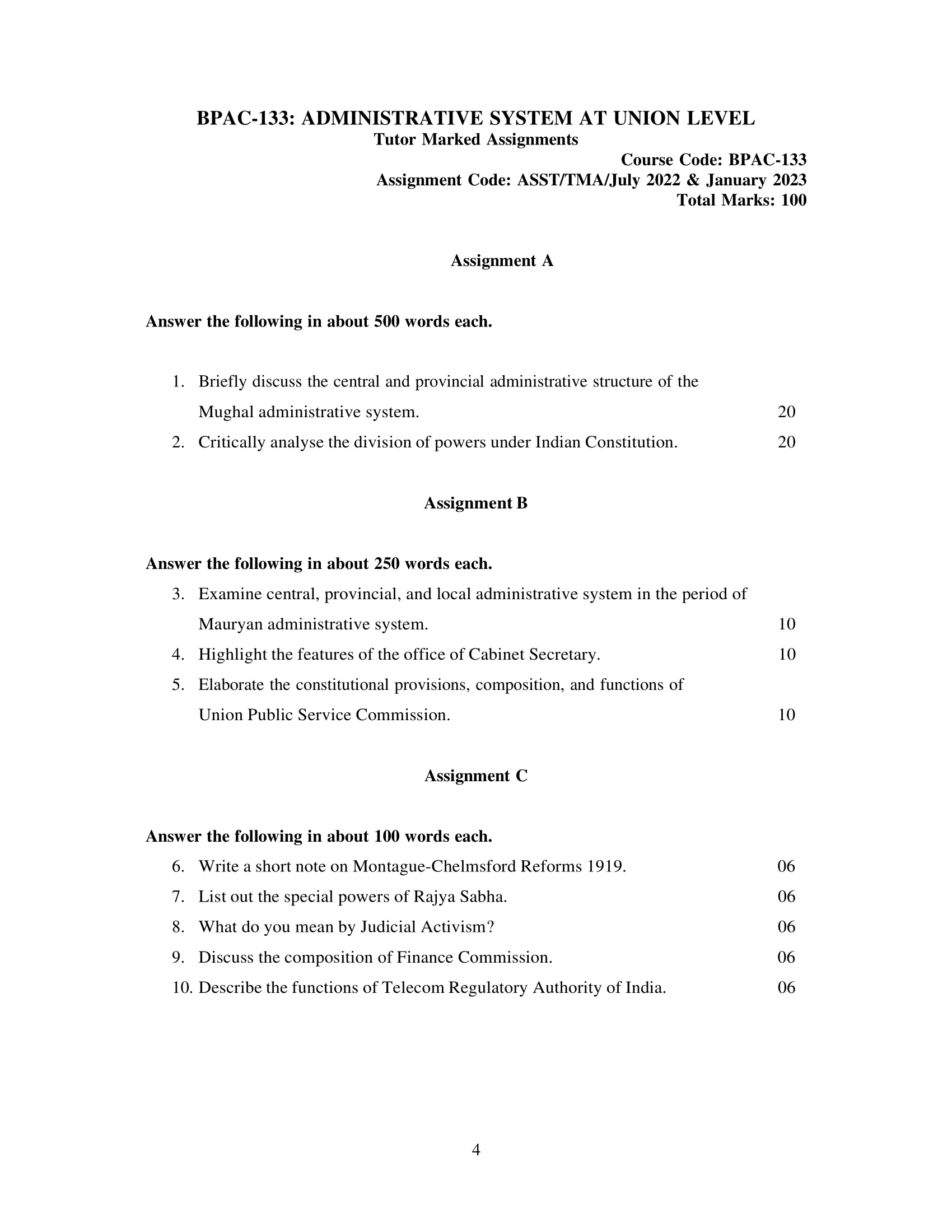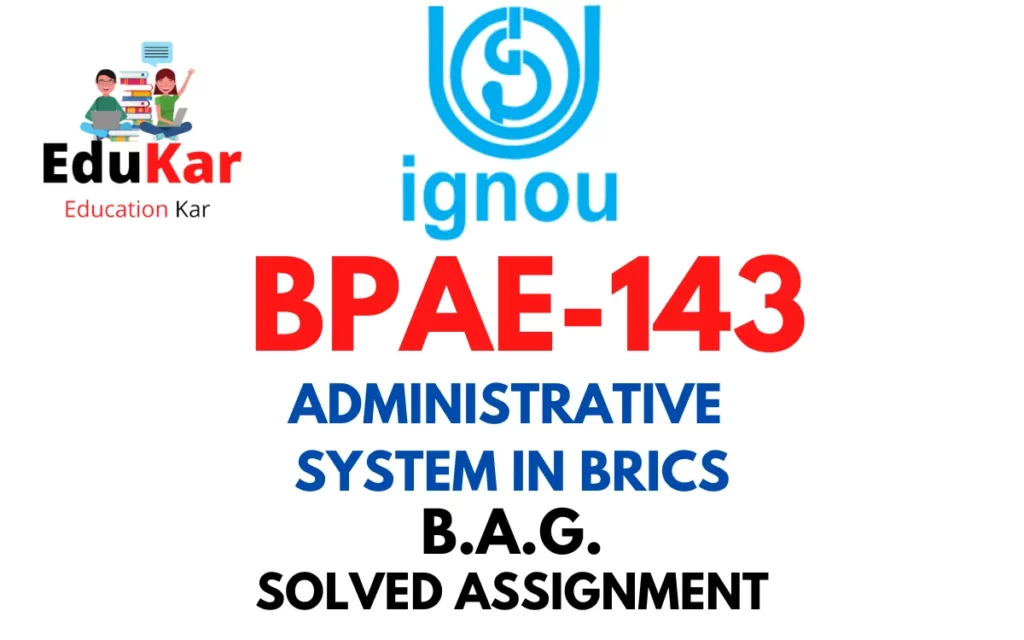Contents
- 1 Assignment A
- 2 Answer the following in about 500 words each.
- 3 1. Briefly discuss the central and provincial administrative structure of the Mughal administrative system.
- 4 2. Critically analyse the division of powers under Indian Constitution.
- 5 Assignment B
- 6 Answer the following in about 250 words each.
- 7 3. Examine central, provincial, and local administrative system in the period of Mauryan administrative system.
- 8 4. Highlight the features of the office of Cabinet Secretary.
- 9 5. Elaborate the constitutional provisions, composition, and functions of Union Public Service Commission.
- 10 Assignment C
- 11 Answer the following in about 100 words each.
- 12 6. Write a short note on Montague-Chelmsford Reforms 1919.
- 13 7. List out the special powers of Rajya Sabha.
- 14 8. What do you mean by Judicial Activism?
- 15 9. Discuss the composition of Finance Commission.
- 16 10. Describe the functions of Telecom Regulatory Authority of India.

| Title | BSOC-132: IGNOU BAG Solved Assignment 2022-2023 |
| University | IGNOU |
| Degree | Bachelor Degree Programme |
| Course Code | BPAC-133 |
| Course Name | ADMINISTRATIVE SYSTEM AT UNION LEVEL |
| Programme Name | Bachelor of Arts (General) |
| Programme Code | BAG |
| Total Marks | 100 |
| Year | 2022-2023 |
| Language | English |
| Assignment Code | ASST/TMA/July 2022 & January 2023 |
| Last Date for Submission of Assignment: | For June Examination: 31st April For December Examination: 30th September |

Assignment A
Answer the following in about 500 words each.
1. Briefly discuss the central and provincial administrative structure of the Mughal administrative system.
Ans: The Mughal Empire, which existed in the Indian subcontinent from the 16th to the 19th century, had a highly sophisticated administrative system that was instrumental in the success and longevity of the empire. The administrative system of the Mughal Empire was centralized, with the emperor holding ultimate authority, but it also included a significant degree of decentralization, with provinces and localities having significant autonomy in managing their own affairs.
The central administrative structure of the Mughal Empire was headed by the emperor, who was the ultimate authority in all matters of governance. The emperor was assisted by a group of ministers and advisors who were responsible for overseeing the administration of the empire. These ministers were divided into several departments, each of which was responsible for a specific aspect of governance. For example, the diwan-i-wuzara was responsible for finance and revenue, the diwan-i-arz was responsible for the military, and the diwan-i-insha was responsible for correspondence and communication.
The central administrative structure also included a number of other important offices, such as the mir bakhshi, who was responsible for the army and its recruitment, and the sadr-i-jahan, who was responsible for religious and charitable matters. The central government also maintained a vast network of spies and intelligence agents who were responsible for gathering information about the empire’s enemies and potential threats.
At the provincial level, the Mughal Empire was divided into a number of subahs or provinces. Each subah was headed by a governor, known as a subahdar, who was responsible for the administration of the province. The subahdar was assisted by a number of officials, including a diwan or revenue officer, a mir bakhshi or military commander, and a qazi or judge. The subah was further divided into a number of sarkars or districts, each of which was headed by a faujdar or military commander, who was responsible for maintaining law and order and collecting revenue.
The Mughal administrative system was highly centralized, with the emperor holding ultimate authority over all matters of governance. However, it also included a significant degree of decentralization, with provinces and localities having significant autonomy in managing their own affairs. This system of centralization and decentralization was instrumental in the success and longevity of the Mughal Empire, as it allowed for efficient governance at both the central and local levels.
2. Critically analyse the division of powers under Indian Constitution.
Ans: The Constitution of India provides for a clear division of powers between the central government and the state governments, in order to ensure a balance of power and effective governance. The division of powers under the Indian Constitution is enshrined in Articles 245-255, and it is structured in a way that allows both the central and state governments to have significant authority and autonomy in managing their respective affairs.
The division of powers under the Indian Constitution is primarily based on the principle of federalism, which means that the powers of the government are divided between the central and state governments. The Constitution of India lists the powers of the central government under the Union List, the powers of the state governments under the State List, and the concurrent powers of both the central and state governments under the Concurrent List. This division of powers ensures that each level of government has a defined and specific role to play, and that they can work together in harmony to achieve common goals.
The central government has been given the power to deal with matters of national importance, such as defense, foreign affairs, currency, and inter-state commerce. On the other hand, the state governments have been given the power to deal with matters that are of local and regional significance, such as law and order, agriculture, education, and health. The Concurrent List includes subjects that are of mutual interest to both the central and state governments, such as marriage and divorce, forests, electricity, and social welfare.
However, despite the clear division of powers between the central and state governments, there have been instances where there has been overlap or conflict. This has led to disputes between the central and state governments, and has sometimes resulted in a breakdown in the system of governance. One of the major causes of this conflict is the interpretation of the Constitution, which is often subject to varying interpretations by different political parties and stakeholders.
Another issue with the division of powers under the Indian Constitution is that it is not always clear which level of government has the final authority in certain matters. This has led to a lack of accountability and confusion in the decision-making process, and has sometimes resulted in delays or inefficiencies in the governance process.
Furthermore, some critics argue that the division of powers under the Indian Constitution is not truly federal in nature, as the central government has significant powers to intervene in matters that are the sole responsibility of the state governments. For example, the central government can declare a state emergency and assume control over the state’s affairs in certain situations, which some argue goes against the principles of federalism.
Assignment B
Answer the following in about 250 words each.
3. Examine central, provincial, and local administrative system in the period of Mauryan administrative system.
Ans: The Mauryan Empire, founded by Chandragupta Maurya in 322 BC, had a well-organized administrative system with three tiers of administration – central, provincial, and local.
The central administration was headed by the emperor, who was assisted by a council of ministers. The emperor had absolute power and was responsible for maintaining law and order, defending the kingdom from external threats, and promoting the welfare of the people. The council of ministers advised the emperor on various matters and assisted in the day-to-day running of the government.
The provincial administration was headed by governors or viceroys who were appointed by the emperor. The empire was divided into several provinces or janapadas, each of which was further divided into districts or vishayas. The governors were responsible for maintaining law and order, collecting taxes, and implementing the policies of the central government. They were assisted by a bureaucracy consisting of district magistrates, tax collectors, and other officials.
The local administration was responsible for maintaining law and order at the grassroots level. The empire was divided into several villages or gramas, each of which was headed by a headman or gramika. The gramika was responsible for maintaining law and order, collecting taxes, and resolving disputes at the local level. They were assisted by a council of elders, who acted as advisors and helped in the day-to-day running of the village.
4. Highlight the features of the office of Cabinet Secretary.
Ans: The Cabinet Secretary is the topmost bureaucrat in the Indian government and the head of the Indian Administrative Service. The office of Cabinet Secretary is considered to be the most powerful and prestigious post in the Indian Civil Services. The main features of the office of the Cabinet Secretary are as follows:
- Highest-ranking civil servant: The Cabinet Secretary is the senior-most civil servant in the country and is responsible for advising the Prime Minister and the Council of Ministers on administrative matters.
- Head of the Civil Services: As the head of the Indian Administrative Service, the Cabinet Secretary is responsible for the overall functioning of the civil services in the country.
- Bridge between the government and bureaucracy: The Cabinet Secretary acts as a bridge between the government and the bureaucracy, and is responsible for ensuring that the government policies are effectively implemented.
- Coordinator of policy implementation: The Cabinet Secretary coordinates the implementation of policies and programs across various ministries and departments, and ensures that they are implemented in a time-bound and efficient manner.
- Crisis management: The Cabinet Secretary is responsible for managing crises and emergencies in the country, and is the nodal officer for disaster management.
- Advisor to the Prime Minister: The Cabinet Secretary is a key advisor to the Prime Minister on all administrative matters, and provides inputs and suggestions on policy matters as well.
- Head of the Civil Services Board: The Cabinet Secretary is the Chairman of the Civil Services Board, which is responsible for the promotion and training of civil servants.
- Conducts meetings of the Secretaries: The Cabinet Secretary conducts meetings of the Secretaries of various ministries and departments, and provides a platform for them to exchange views and ideas.
5. Elaborate the constitutional provisions, composition, and functions of Union Public Service Commission.
Ans: The Union Public Service Commission (UPSC) is a constitutional body in India responsible for conducting recruitment exams and selecting candidates for various central civil services and posts. The provisions related to the UPSC are enshrined in Part XIV of the Indian Constitution, under Articles 315 to 323.
Composition of the UPSC: The UPSC consists of a chairman and other members appointed by the President of India. The number of members is not fixed by the Constitution, and it is determined by the President. The chairman and members of the UPSC hold office for a term of six years or until they attain the age of 65 years, whichever is earlier. The chairman of the UPSC can be removed from office by the President only on the grounds of misbehavior or incapacity.
Functions of the UPSC: The main functions of the UPSC are as follows:
- Recruitment of civil servants: The UPSC is responsible for conducting recruitment exams for various central civil services and posts, such as the Indian Administrative Service (IAS), Indian Police Service (IPS), Indian Foreign Service (IFS), and Indian Revenue Service (IRS).
- Advising the government: The UPSC advises the government on matters related to recruitment, promotions, and transfers of civil servants.
- Conducting examinations: The UPSC conducts various exams such as the Civil Services Examination, Combined Defence Services Examination, Engineering Services Examination, and many others.
- Appointment of officers: The UPSC recommends suitable candidates for appointment to various civil services and posts to the government.
- Disciplinary matters: The UPSC conducts disciplinary proceedings against civil servants accused of misconduct.
- Promotions: The UPSC advises the government on the promotions of civil servants.
- Regulations: The UPSC makes regulations on matters related to the conditions of service of civil servants.
Assignment C
Answer the following in about 100 words each.
6. Write a short note on Montague-Chelmsford Reforms 1919.
Ans: The Montague-Chelmsford Reforms of 1919 were a series of constitutional reforms introduced by the British government in India. The reforms aimed to provide Indians with a greater say in the governance of their country and to create a more representative political system. The reforms led to the establishment of a bicameral legislature at the national level, with some limited powers to make laws. They also allowed for the establishment of provincial legislatures, with some degree of autonomy. However, the reforms fell short of the demands of Indian nationalists, who called for greater autonomy and self-rule.
7. List out the special powers of Rajya Sabha.
Ans: The Rajya Sabha, or the Council of States, is the upper house of the Indian Parliament. It is a permanent body and has certain special powers that distinguish it from the Lok Sabha, or the lower house. Some of the special powers of the Rajya Sabha are:
- Representation of States: The Rajya Sabha represents the interests of the states of India, with each state having a set number of members in the house. This ensures that the interests of smaller states are also represented in the Parliament.
- Electoral College for President and Vice-President: The members of the Rajya Sabha, along with members of the Lok Sabha and state legislative assemblies, form the electoral college for the election of the President and Vice-President of India.
- Financial Matters: The Rajya Sabha has certain powers with regard to financial matters. It can recommend changes to money bills, which are introduced in the Lok Sabha, and can also initiate non-money bills related to finance.
- Impeachment: The Rajya Sabha, along with the Lok Sabha, has the power to initiate the process of impeachment of the President, Vice-President, and other constitutional authorities, such as judges of the Supreme Court and High Courts.
- Special Powers in Case of National Emergency: In case of a national emergency, the Rajya Sabha can be given special powers. The President can authorize the Rajya Sabha to pass legislation on matters that are ordinarily under the jurisdiction of the state governments.
- Approval of International Treaties and Agreements: The Rajya Sabha must give its approval to any international treaty or agreement before India can become a signatory.
8. What do you mean by Judicial Activism?
Ans: Judicial activism refers to a judicial philosophy in which judges actively interpret and enforce the Constitution, laws, and other legal principles, sometimes even overruling the other branches of government in the process. Judicial activism is often associated with the idea of the courts playing an active role in shaping public policy and bringing about social change.
The concept of judicial activism is often contrasted with judicial restraint, which is the idea that judges should be cautious and deferential in interpreting the law and should limit their role to interpreting the law as it is written, without expanding its meaning or application.
Judicial activism can take many forms, such as expanding the interpretation of constitutional provisions, striking down unconstitutional laws, interpreting statutory provisions in a broad or flexible manner, and expanding the scope of legal rights and protections. This can be seen as an attempt to promote justice, equality, and the protection of individual rights, particularly for marginalized groups or those who may be disadvantaged by the legal system.
Critics of judicial activism argue that it undermines the principle of separation of powers and can lead to a concentration of power in the judiciary, potentially leading to an imbalance in the democratic system. Some also argue that judicial activism can lead to a politicization of the judiciary, and that judges may use their powers to advance their own personal or political agendas.
Proponents of judicial activism argue that it is necessary to ensure that the law evolves with society, and that the judiciary plays a key role in protecting the rights and freedoms of citizens. They argue that the judiciary has a duty to interpret the law in a way that advances the cause of justice and fairness, and that this can be done without violating the principles of democracy or the rule of law.
9. Discuss the composition of Finance Commission.
Ans: The Finance Commission is a constitutional body in India that is responsible for recommending the distribution of financial resources between the central government and the state governments. The Finance Commission is constituted by the President of India every five years or at such intervals as he may deem necessary. The composition of the Finance Commission is as follows:
- Chairman: The Finance Commission is headed by a chairman who is appointed by the President. The chairman must be a person who has had experience in public affairs or has special knowledge of finance and accounts.
- Members: The Finance Commission has four other members who are appointed by the President. These members are typically experts in economics, finance, and public administration. At least one member of the commission must be from a Scheduled Caste or Scheduled Tribe.
- Terms of Service: Members of the Finance Commission hold office for a period of five years or until their successors are appointed, whichever is earlier.
- Powers and Functions: The Finance Commission has a range of powers and functions, including making recommendations to the President on the distribution of taxes and duties between the central government and the state governments, the principles that should govern the grants-in-aid to be given to the states, and the measures needed to augment the resources of the Panchayats and Municipalities.
In addition to the above, the Finance Commission has the power to summon and enforce the attendance of witnesses, to call for the production of documents, and to requisition any public record. The Commission is also empowered to regulate its own procedure and to have such powers as are vested in a civil court.
10. Describe the functions of Telecom Regulatory Authority of India.
Ans: The Telecom Regulatory Authority of India (TRAI) is an independent regulatory body responsible for regulating the telecommunications industry in India. The functions of TRAI are:
- Licensing: TRAI issues licenses to telecom service providers for operating in various parts of the country.
- Tariff regulation: TRAI regulates the tariffs charged by telecom service providers and ensures that they are reasonable and affordable.
- Quality of service regulation: TRAI monitors the quality of service provided by telecom service providers and ensures that the quality standards are met.
- Consumer protection: TRAI protects the interests of consumers by ensuring that telecom service providers adhere to consumer protection guidelines.
- Dispute resolution: TRAI resolves disputes between telecom service providers and consumers.
- Policy formulation: TRAI formulates policies for the growth and development of the telecom sector in India.
- Spectrum management: TRAI manages the allocation and pricing of spectrum, which is a crucial resource for the telecom industry.
How to Download BPAC-133 Solved Assignment?
You can download it from the www.edukar.in, they have a big database for all the IGNOU solved assignments.
Is the BPAC-133 Solved Assignment Free?
Yes this is absolutely free to download the solved assignment from www.edukar.in
What is the last submission date for BPAC-133 Solved Assignment?
For June Examination: 31st April, For December Examination: 30th October















